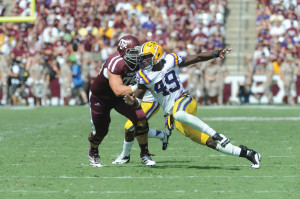Are some positions safer than others in the draft? Conventional wisdom tells us that quarterbacks are risky, while offensive linemen are safe. But is that true? Jason Lisk wrote a great article on bust rates three years ago at the old PFR Blog, and I’ve decided to update that article based on more recent data.
I looked at the first rounds of all drafts from 1990 to 2009. Over that time period, 46 quarterbacks were selected in the first round, and those quarterbacks were selected, on average, with the 9th or 10th pick. The table below breaks down each position, the number of players selected in the twenty-year period, and their average draft slot:
After quarterbacks, defensive ends, outside linebackers, offensive tackles, and defensive tackles have the highest average draft slot (if you include the data from 2010, 2011, and 2012, defensive tackle actually slides into the #2 spot). This reflects the Planet Theory in the NFL: there are only so many people that big with that much athleticism walking the planet, so when NFL scouts find them, they draft them. Early.
We can also see the average AV produced by each position in each of their first four seasons, along with their total AV through four seasons. Inside linebackers and running backs are the most productive players early on in their career, which makes sense if you consider that those positions tend to age very poorly and youth rules the day:
But looking at just average AV doesn’t tell us a lot about bust rates. So here’s what I did. I went through and measured how each draft pick performed (in terms of AV) through four years, relative to expectation (i.e., his draft slot). There were just over 600 players in the study: I labeled the top 100 overachievers (relative to expectations) as “Great” and the next 100 as “Good” while I tagged the 100 biggest underachievers as “busts” and the next 100 as “Bad.” Everyone else was labeled average.
Here’s how you can read the table below, based on the defensive end line. There were 74 defensive ends selected in the first rounds of drafts from 1990 to 2009, with the average first round end being selected with the 14th pick. Only 5% of them were huge overachievers, while 18% were good, 36% were average, 20% were bad, and 20% were labeled as busts.
On the other hand, defensive ends and outside linebackers are just as likely to fall into one of the bottom two buckets as quarterbacks. Pass rushers may be in high demand but they’re not any safer than quarterbacks. You shouldn’t be surprised if two out of Dion Jordan, Ziggy Ansah, Barkevious Mingo, Jarvis Jones, and Tank Carradine turn into this generation’s version of Aaron Maybin, Vernon Gholston, Jarvis Moss, Larry English, Derrick Harvey, or Robert Ayers. Just like with quarterbacks, I think teams find themselves all too willing to overlook certain flaws when it comes to scouting pass rushers.
I’m a little surprised to admit it, but offensive lineman do appear to be relatively safe here, coming in as neither particularly high in the great or bust category. In general, though, I’m skeptical that we can infer much from this data — the sample sizes aren’t large, and I wouldn’t be surprised if some of these trends reverse themselves over the next few years.
What are your thoughts?

